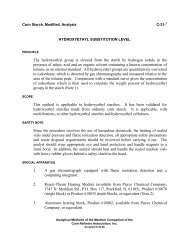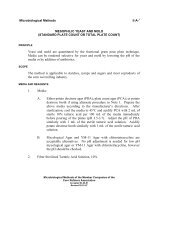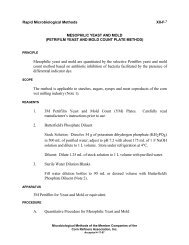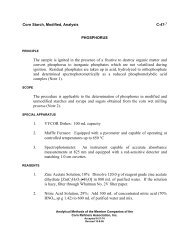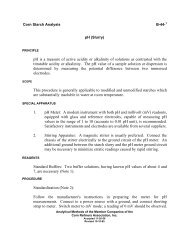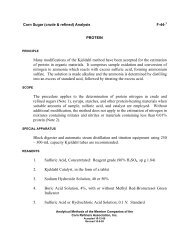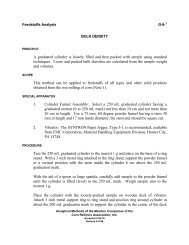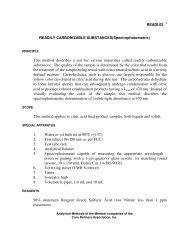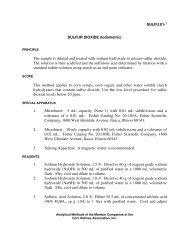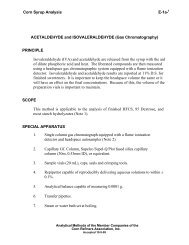Corn
2007 Corn Annual - Corn Refiners Association
2007 Corn Annual - Corn Refiners Association
- No tags were found...
You also want an ePaper? Increase the reach of your titles
YUMPU automatically turns print PDFs into web optimized ePapers that Google loves.
Refined <strong>Corn</strong> Products:Growing Markets Around the WorldTake a look at the list of plant locationsowned and operated by members of theU.S. corn refining industry and you willsee a world of opportunity. <strong>Corn</strong> wet millingplants provide value added products to peoplethroughout the world. While the U.S. cornrefining industry is primarily a domesticsupplier of ingredients and industrial inputs,many overseas markets have come to rely onthe quality, value and availability of ourproducts. Never satisfied with the status quo,the industry has long been a beacon oftechnological advancement in the area ofproduct quality and development. Many of ouroverseas customers recognize this and chooseU.S. refined corn products over alternatives.Exports of refined corn products account forover 20% of total shipments—a healthy figureespecially given the domestic nature of theindustry. We saw an encouraging 13%increase in the value of exports of refined cornproducts in 2006 over the previous year.Exports during the first three quarters of 2007were up 18% over the same period in 2006.Tracking exports of refined corn products overthe past twenty years provides a glimpse intothe growth capacity of this segment of theindustry’s business. As the world’s populationgrows and many areas experience increasedeconomic prosperity, U.S. corn refiners are ina strong position to provide the ingredients toenable regional food and beveragemanufacturers to meet the increasingsophistication of consumer needs and palates.Additionally, refined corn products areessential to a number of industrial productsthat will see increased demand as economiesexpand.Exports: The Ups and DownsExports of refined corn products saw a healthyrate of growth in the late 1980s and most ofthe 1990s (see page 8). The average annualrate of growth during this period was 6%.Then in the late 1990s, we began to see adecline in exports. Much of this can beattributed to a decrease in exports to theEuropean Union.For many years, U.S. corn refiners wereexporting about 5 million tons of corn glutenfeed to Europe annually under a zero-dutybinding negotiated in the 1960s. We began tosee this market shrink when tensions betweenthe European Union and the United Statesincreased over biotech corn varieties. Whilethe U.S. quickly embraced the newtechnology, the European Union was muchslower to do so and imposed restrictions on thetypes of corn that could be imported. Refinedcorn feed product exports to the EuropeanUnion dropped to 2.24 million metric tons in2006 from 5 million metric tons ten yearsearlier, a decline of $474 million.The barriers to biotech corn in the EuropeanUnion have had the greatest impact on feedproducts, but we have seen a reduction inmarkets for all refined corn products to theEuropean Union. In October 2007, theEuropean Union authorized three biotech cornvarieties for import increasing the list ofapproved varieties to 10 for food use and 14for feed use. These are the first approvalssince the European Union ended a six-yearmoratorium on new biotech products in 2004.However, the European Union is facing asignificant shortage of feed products due tonatural disasters that significantly reducedregional production. It is estimated thatEurope will need 17 to 18 million metric tonsof feed grains next year. The slow pace ofapprovals of new biotech varieties threatens toturn the European Union into a net meatimporting region of the world as early as 2009given this projected feed shortage.Regional Trade AgreementsRegional trade agreements have been and willbe a significant factor in expanding exportmarkets. Exports of refined corn products tothe Western Hemisphere should increasesignificantly due to implementation of theUnited States-Central American-DominicanRepublic Free Trade Agreement (CAFTA-DR).Tariffs on corn starch, corn oil, glucose anddextrose, and corn gluten feed and meal wereeliminated when CAFTA-DR wasimplemented in 2005. Exports to CAFTA-DRcountries increased nearly 60% between 2005and 2006 to about $36 million. If the firstthree quarters of 2007 are indicative of theexpected growth rate for 2007, again we willJames P. ZallieChairman of the Board<strong>Corn</strong> Refiners AssociationGroup Vice President,National Starch andChemical Company2007 <strong>Corn</strong> Annual | 7



